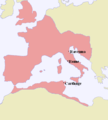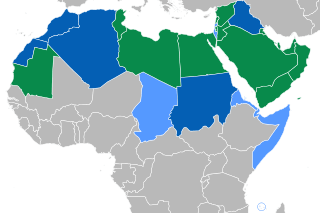World language
A world language is a language that is spoken internationally and is learned and spoken by a large number of people as a second language. A world language is characterized not only by the total number of speakers (native and second language speakers), but also by its geographical distribution, as well as use in international organizations and diplomatic relations.[1][2] By these criteria, the major world languages are of Western European origin, having been spread through European colonialism.
Overview
One of the most widely spoken and fastest spreading world languages today is English, which has over 900 million first- and second-language users worldwide.[3] It is estimated to have as many as 600 million second-language speakers,[3] including anywhere between 200 and 350 million learners/users in China alone,[4] at varying levels of study and proficiency, though this number is difficult to accurately assess.[5] English is also increasingly becoming the dominant language of scientific research and papers worldwide, having even outpaced national languages in Western European countries, including France, where a recent study showed that English has massively displaced French as the language of scientific research in "hard" as well as in applied sciences.[6]
French, which has long been the language of communication and diplomacy, and the favored second language among the elite and the educated classes in Europe, including Russia, Greece, Romania, Bulgaria and Ottoman Turkey, as well as in Egypt, Lebanon, Iran and South America, had declined steadily since World War I, but still remains one of the working languages of many international organizations, including the United Nations.[7] Arabic gained international prominence because of the medieval Islamic conquests and the subsequent Arabization of the Middle East and North Africa, and is also a liturgical language amongst Muslim communities outside the Arab World. Standard Chinese is the direct replacement of Classical Chinese, which was a historical lingua franca in Far East Asia until the early 20th century, and today serves as a common language between speakers of other varieties of Chinese not only within China proper (between the Han Chinese and other unrelated ethnic groups), but in overseas Chinese communities. It is also widely taught as a second language internationally. Russian was used in the Russian Empire and the Soviet Union, and its teaching was made compulsory in the Eastern Bloc countries. However, the use and teaching of Russian has declined sharply in both the former Eastern bloc and the near abroad since the break up of the Soviet Union and Russia’s deputy education minister was quoted as saying in December 2013 that the number of Russian speakers had fallen by 100 million since that date.[8][9][10] Spanish was used in the Spanish Empire and today is in use in Spain, in Latin American countries (except Brazil, French Guyana, Haiti and other Caribbean islands), and is spoken in many parts of the United States, particularly in Florida and the states which border Mexico. German served as a lingua franca in large portions of Europe for centuries, mainly the Holy Roman Empire and later the Austro-Hungarian Empire. It remains an important second language in much of Central and Eastern Europe, and in the international scientific community.
The major languages of the Indian subcontinent have numbers of speakers comparable to those of major world languages primarily due to the large population in the region rather than a supra-regional use of these languages, although Hindustani (including all Hindi dialects, and Urdu), Bengali and to a lesser extent Tamil may fulfill the criteria in terms of supra-regional usage and international recognition.
As an example, the native speaking population of Bengali vastly outnumber those who speak French as a first language, and it is one of the most spoken languages (ranking fifth[11] or sixth[12]) in the world with nearly 230 million total speakers, and is known for its long and rich literary tradition. However, while French is spoken intercontinentally, is internationally recognized to be of high linguistic prestige and used in diplomacy and international commerce, as well as having a significant portion of second language speakers throughout the world, the overwhelming majority of Bengali speakers are native Bengali people, with not much influence outside of its regionally limited sprachraum or language space.
History
Historical languages which had international significance as the lingua franca of a historical empire include Egyptian in Ancient Egypt; Sumerian, Akkadian and Aramaic in the various Mesopotamian civilizations and empires in the Ancient Near East; Ancient Greek in the Greek colonies in the form of various dialects, evolving to Koine Greek in the Hellenistic world, after the conquests of Alexander the Great and the Macedonian Empire, and subsequently in the eastern part of the Roman Empire and the territories of the Byzantine Empire; Latin in the Roman Empire and presently as the standard liturgical language for the Catholic faithful worldwide; Classical Chinese in East Asia during the Imperial era of Chinese history; Persian during the various succeeding Persian Empires, and once served as the second lingua franca of the Islamic World after Arabic;[13] Sanskrit and Tamil during the ancient and medieval historical periods of various states in South Asia, Southeast Asia, and Central Asia, and like Latin an important liturgical language of the Vedic religions and Shaivism.
The Romance languages bear testimony to the role of Latin as the lingua franca of the Roman Empire; for example, Italian has always been important in the Mediterranean region, and nowadays it is the most-spoken language among members of the Roman catholic hierarchy and it is also used in music (especially Opera) and the fashion industry. Turkish was similarly important as the primary language of the Ottoman Empire. Koine Greek was the "world language" of the Hellenistic period, but its distribution is not reflected in the distribution of Modern Greek due to the linguistic impact of the Slavic, Arabic and Turkic expansions. The distribution of the Arabic and Turkic languages, in turn, are a legacy of the Caliphates and the Turkic Khaganate, respectively.
Just as all the living world languages owe their status to linguistic imperialism, the suggestion of a given language as a world language or "universal language" has strong political implications. Thus, Russian was declared the "world language of internationalism" in Soviet literature, which at the same time denounced French as the "language of fancy courtiers" and English as the "jargon of traders".[14] A number of international auxiliary languages have been introduced as prospective world languages, the most successful of them being Esperanto, but none were learned by as many people as the world languages were. Many natural languages have been proffered as candidates for a global lingua franca.[14]
Living world languages
Some sources[15][16] define a living world language as having the following properties:
- a large number of speakers
- a substantial fraction of non-native speakers (function as lingua franca)
- official status in several countries
- use across several regions in the world
- a linguistic community not defined strictly along ethnic lines (multiethnic, pluricentric language)
- one or more standard registers which are widely taught as a foreign language
- association with linguistic prestige
- use in international trade relations
- use in international organizations
- use in the academic community
- significant body of literature
Certain languages with greater than 100 million speakers, such as Japanese, are not listed. Japanese, although considered to be one of the most significant languages internationally, along with the listed world languages,[17] it is not considered a world language per se. Japan as a region is nearly homogeneous from ethnic, cultural and linguistic standpoints. Thus Japanese has little history as a lingua franca amongst communities who do not share a mother tongue or first language; their overseas communities are strongly tied to ethnicity. While international interest since the 1980s has prompted many major universities, secondary schools, and even primary schools worldwide to offer courses in the language, Japanese only exerts a regionally limited sphere of influence.[18]
Languages which are often considered world languages include:[1][19][20]
| Language | Native speakers[21] | Second speakers of the language[21] | Students as a foreign language | Total speakers | Official Status Distribution | Official Status Maps |
|---|---|---|---|---|---|---|
| English | 335 M[22] | 505 M[22] | 600 M[5] | 1500 M[5] | List of territorial entities where English is an official language | .png) |
| French | 76 M | 87 M | 100 M[23] | 274 M[24] | List of territorial entities where French is an official language | |
| Spanish | 400 M | 89 M | 21 M[25] | 559 M[26] | List of countries where Spanish is an official language |  |
Other sources denote the following languages as world languages, whilst stricter sources list them as supra-regional languages:[2]
| Language | Native speakers[21] | First and second speakers of the language[21] | Official Status Distribution | Official Status Maps |
|---|---|---|---|---|
| Mandarin Chinese | 955 M[27] | 1151 M[28] | List of territorial entities where Chinese is an official language |  |
| Arabic | 353.5 M (206 million native speakers of all Arabic varieties + 246 million Arabic speakers as a second language of all Arabic varieties - 100.5 million not well-educated and have not adequate proficiency in Standard Arabic)[29] | List of countries where Arabic is an official language |
| |
| Portuguese | 220 M | 260 M[30] | List of territorial entities where Portuguese is an official language | 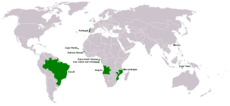 |
| Russian | 171 M[31] | 260 M[32] | List of territorial entities where Russian is an official language |  |
| German | 95 Mα (Standard German only: 78 M) | 105 M[33] | List of territorial entities where German is an official language |  |
| Dutch and Afrikaans | 28 M | 46 M | Geographical distribution of Dutch and Afrikaans | 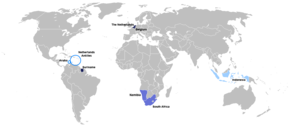 |
Other supra-regional languages
Other languages of supra-regional importance which fail some of the other criteria to be considered de facto world languages include:
| Language | Native speakers[21] | Total speakers | Official Status Distribution | Official Status Maps |
|---|---|---|---|---|
| Hindustani (Standard Hindi, Urdu) | 323.4 M (260M Hindi, 63.4 Urdu) | 484 M (380M Hindi, 104 Urdu) | Indian subcontinent |  |
| Bengali | 220 M | 300 M | Official language in: Bangladesh and in the Indian states of West Bengal, Tripura and Assam | 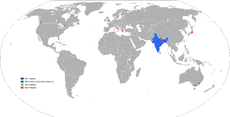 |
| Malay and Indonesian | 60 M | 176–250 M | Nusantara (Malay world) | 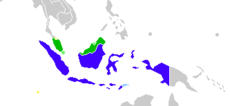 |
| Swahili | 15 M[34] | 150 M[35][36] | East Africa | 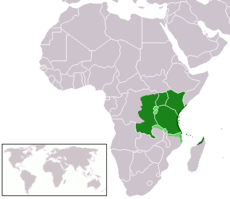 |
| Persian | 60 M[37] | 110 M[37] | Greater Iran |  |
| Turkish | 83 M | 100 M[38][39] | Official language in: Turkey, Cyprus, Northern Cyprus Recognized minority language in: Bosnia and Herzegovina, Macedonia, Romania, Iraq, Greece, Republic of Kosovo |  |
| Italian | 60 M | 85 M[40] | Official language in: Italy, Switzerland, San Marino, Sovereign Military Order of Malta, Vatican City. Italian is relevant in countries affected by the Italian diaspora and in former colonies and occupied territories of the Italian Empire. |  |
| Tamil | 70 M | 78 M | Official language in: Sri Lanka, Singapore, and Indian states of Tamil Nadu and Puducherry. It is also recognized as minority language in Malaysia and Mauritius. |  |
See also
- List of languages by total number of speakers
- National language
- Universal language
- Lingua franca
- International English
- World religion
- World population
- World economy
- World Englishes
- International auxiliary language
- Global language system
- List of languages by number of native speakers
Notes
- ^α In contrast to other pluricentric languages (e.g., Arabic or Malay), Ethnologue only lists "Standard German", thereby excluding Swiss German and numerous other varieties of German. Summing up Standard German as well as all undisputed German dialects/varieties (see ISO-list in infobox at German language) that are not listed under "Standard German" results in ca. 90 M native speakers. Furthermore, Ammon (2014)[33] points out that Ethnologue overestimates L2 speakers, thus underestimating L1 speakers, in Germany by 5M --> 95M L1 speakers.
- 1 2 Fischer Verlag Weltalmanach stichwort_weltsprachen Archived September 4, 2009, at the Wayback Machine.
- 1 2 Baker & Jones Encyclopedia of bilingualism and bilingual education
- 1 2 "English". Ethnologue. Retrieved 2016-10-29.
- ↑ Wei, Rining; Jinzhi Su (2012). "The statistics of English in China". English Today. Cambridge University Press. 28 (03): 10–14. doi:10.1017/s0266078412000235. Retrieved 30 October 2016.
- 1 2 3 Crystal, David (2006). "9 - English worldwide pp. 420-439". Cambridge University Press. Cambridge University Press. Retrieved 2015-12-15.
- ↑ Héran, François (21 May 2013). "L'anglais hors la loi ? Enquête sur les langues de recherche et d'enseignement en France" [English outlaws? Investigation into research and teaching languages in France] (PDF) (in French). Population & Sociétés. Archived from the original (PDF) on 11 October 2014.
- ↑ "Official Languages | United Nations". www.un.org. Retrieved 2016-10-29.
- ↑ http://thediplomat.com/2015/01/russias-waning-soft-power-in-central-asia/
- ↑ http://www.eurasianet.org/node/71376
- ↑ http://www.voanews.com/content/english-replaces-russian-as-top-foreign-language-of-study-in-ex-soviet-georgia/1528063.html
- ↑ "Statistical Summaries". Ethnologue. 2005. Retrieved 2007-03-03.
- ↑ Languages Spoken by More Than 10 Million People. Microsoft Encarta 2006. Archived from the original on January 9, 2006. Retrieved 2007-02-18.
- ↑ Dr Seyyed Hossein Nasr, Islam: Religion, History, and Civilization, HarperCollins,Published 2003
- 1 2 Pei, p. 105
- ↑ WiseGeek.com - WWhat is world language?
- ↑ TheAtlantic.com - What Global Language?
- ↑ The World's 10 most influential Languages
- ↑ c.f. Pei p. 15
- ↑ Ulrich Ammon Status and function of languages and language varieties
- ↑ Ali Mazrui A world federation of cultures: an African perspective
- 1 2 3 4 5 Ethnologue: Statistical Summaries
- 1 2 "English Language | Ethnologue". Ethnologue. 2015-12-16. Retrieved 2015-12-16.
- ↑ "Le français, une langue mondiale" [French, a world language] (PDF) (in French). French Ministry of Foreign and European Affairs. May 2012. Retrieved 30 October 2016.
- ↑ 2014 "The French language worldwide" report unveiled by Organisation de la Francophonie
- ↑ Instituto Cervantes 2015 (page 10)
- ↑ Instituto Cervantes (página 8)
- ↑ Mikael Parkvall (2010). "Världens 100 största språk 2010" [The World's 100 Largest Languages in 2010]. Nationalencyklopedin. Retrieved 2015-07-19.
- ↑ "The 30 Most Spoken Languages of the World". KryssTal. 2010. Retrieved 2015-07-19.
- ↑ www.ethnologue.com/language/arb
- ↑ Instituto Internacional da Língua Portuguesa
- ↑ Lewis, M. Paul; Simons, Gary F.; Fennig, Charles D., eds. (2016). "Russian language". Ethnologue. Retrieved 26 June 2016.
- ↑ Голодец: русский язык знают около 260 миллионов человек в мире [Golodets: the Russian language is known by about 260 million people worldwide]. RIA Novosti (in Russian). 28 October 2014. Retrieved 26 June 2016.
- 1 2 Ammon, Ulrich - Die Stellung der deutschen Sprache in der Welt (de Gruyter Mouton; ISBN 978-3-11-019298-8)
- ↑ Swahili at Ethnologue (18th ed., 2015)
- ↑ Abiola Irele; Biodun Jeyifo (2010). The Oxford Encyclopedia of African Thought. Oxford University Press. p. 362. ISBN 978-0-19-533473-9.
- ↑ Swahili language (Stanford website)
- 1 2 Windfuhr, Gernot: The Iranian Languages, Routledge 2009, p. 418.
- ↑ Katzner
- ↑ http://ec.europa.eu/public_opinion/archives/ebs/ebs_243_en.pdf
- ↑ Italian language University of Leicester
References
- Christian Mair (ed.), The Politics of English As a World Language (2003), ISBN 978-90-420-0876-2.
- Mario Pei, One Language for the World (1958), ISBN 978-0-8196-0218-3.
- Anne-Marie De Mejía, Power, Prestige, and Bilingualism: International Perspectives on Elite Bilingual Education (2002), ISBN 978-1-85359-590-5.
- David Crystal, English as a Global Language (2003), ISBN 978-0-521-53032-3.
- Clare Mar-Molinero, The Politics of Language in the Spanish-speaking World (2000), ISBN 978-0-415-15655-4.
- George Weber, The World's 10 most influential Languages
External links
- World language on Facebook
- English 'world language' forecast (BBC, December 2004)
- World Language Maps
- 1903 article - Are We To Have An International Language?
